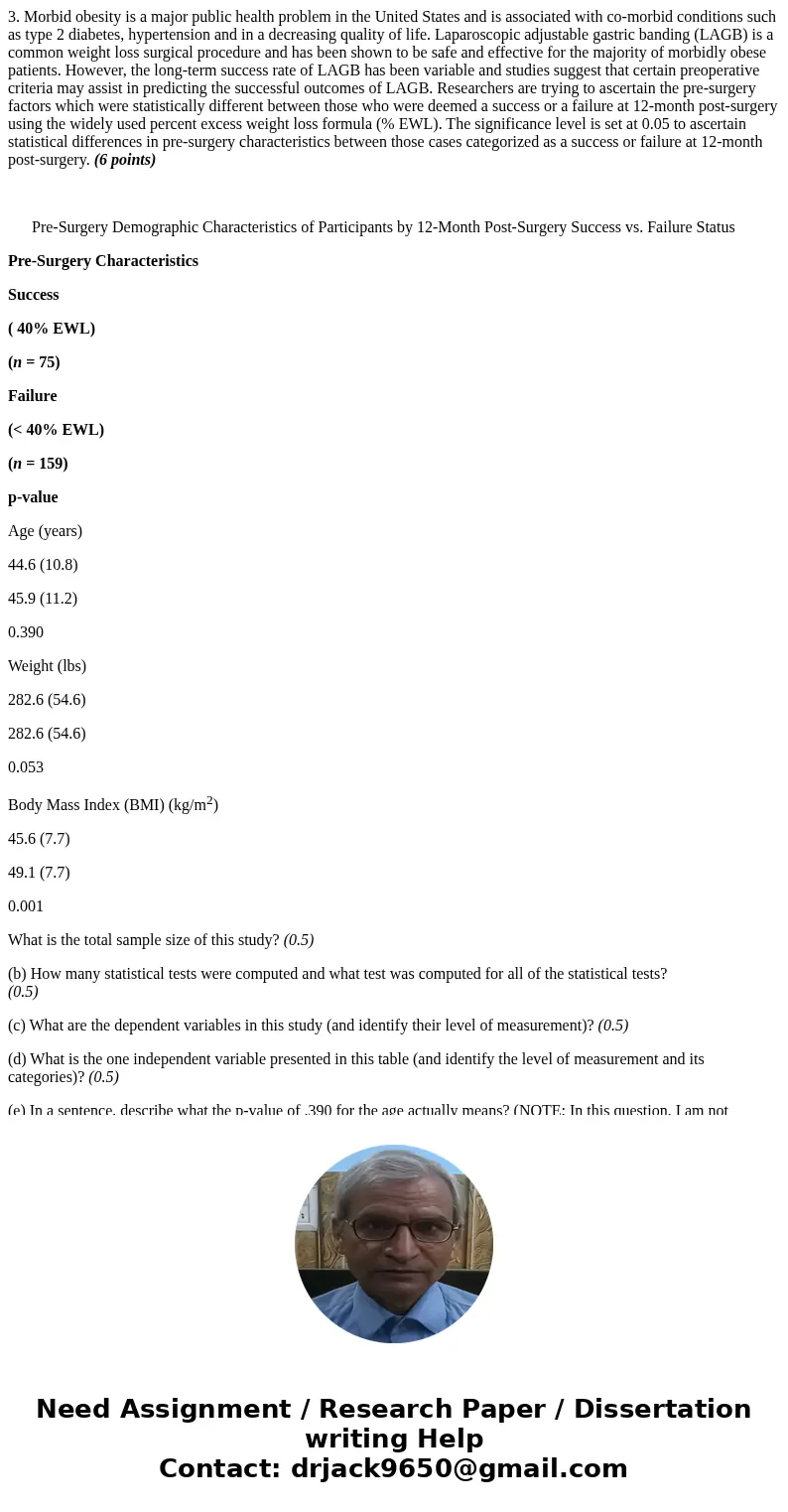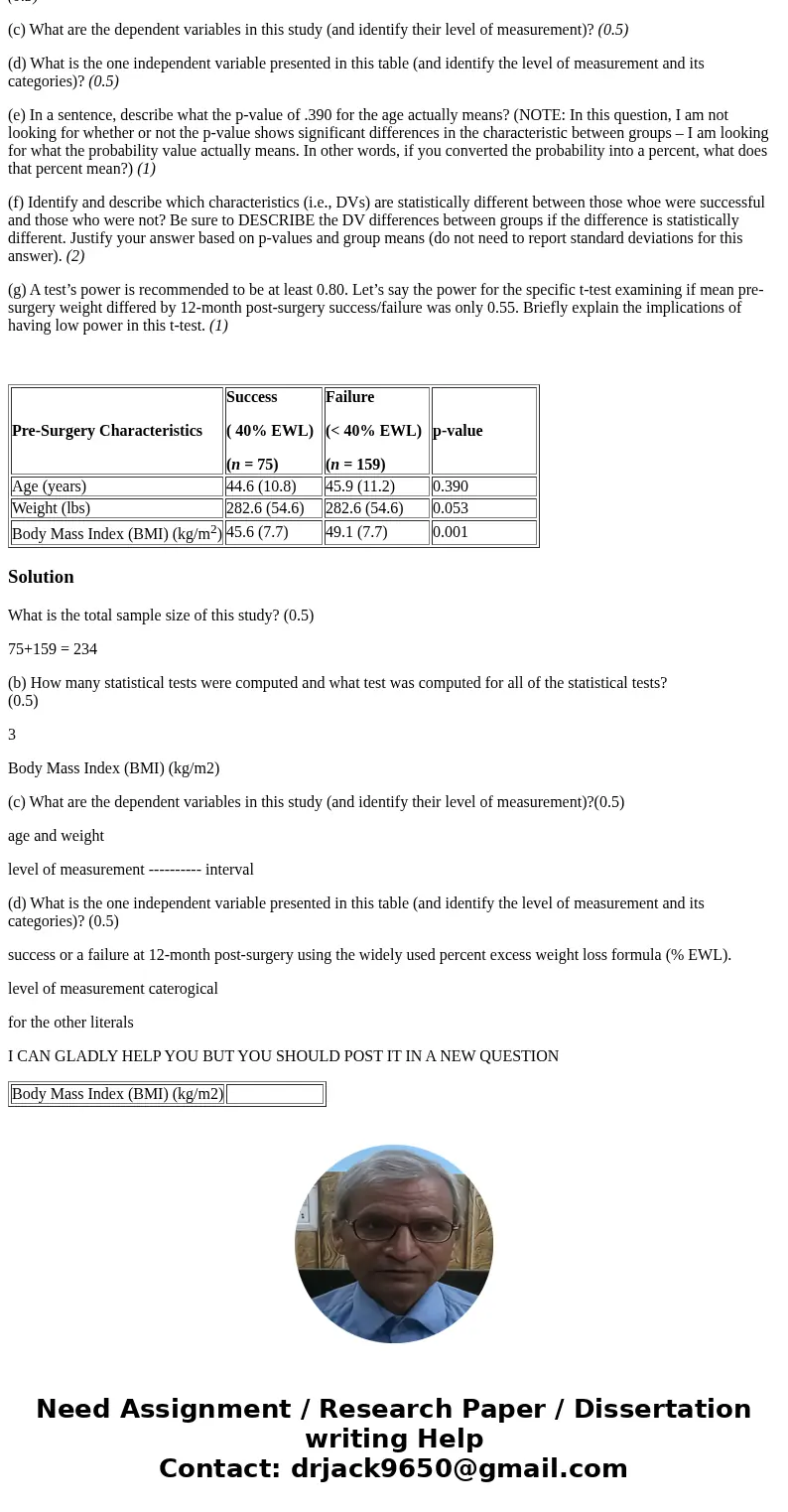3 Morbid obesity is a major public health problem in the Uni
3. Morbid obesity is a major public health problem in the United States and is associated with co-morbid conditions such as type 2 diabetes, hypertension and in a decreasing quality of life. Laparoscopic adjustable gastric banding (LAGB) is a common weight loss surgical procedure and has been shown to be safe and effective for the majority of morbidly obese patients. However, the long-term success rate of LAGB has been variable and studies suggest that certain preoperative criteria may assist in predicting the successful outcomes of LAGB. Researchers are trying to ascertain the pre-surgery factors which were statistically different between those who were deemed a success or a failure at 12-month post-surgery using the widely used percent excess weight loss formula (% EWL). The significance level is set at 0.05 to ascertain statistical differences in pre-surgery characteristics between those cases categorized as a success or failure at 12-month post-surgery. (6 points)
Pre-Surgery Demographic Characteristics of Participants by 12-Month Post-Surgery Success vs. Failure Status
Pre-Surgery Characteristics
Success
( 40% EWL)
(n = 75)
Failure
(< 40% EWL)
(n = 159)
p-value
Age (years)
44.6 (10.8)
45.9 (11.2)
0.390
Weight (lbs)
282.6 (54.6)
282.6 (54.6)
0.053
Body Mass Index (BMI) (kg/m2)
45.6 (7.7)
49.1 (7.7)
0.001
What is the total sample size of this study? (0.5)
(b) How many statistical tests were computed and what test was computed for all of the statistical tests? (0.5)
(c) What are the dependent variables in this study (and identify their level of measurement)? (0.5)
(d) What is the one independent variable presented in this table (and identify the level of measurement and its categories)? (0.5)
(e) In a sentence, describe what the p-value of .390 for the age actually means? (NOTE: In this question, I am not looking for whether or not the p-value shows significant differences in the characteristic between groups – I am looking for what the probability value actually means. In other words, if you converted the probability into a percent, what does that percent mean?) (1)
(f) Identify and describe which characteristics (i.e., DVs) are statistically different between those whoe were successful and those who were not? Be sure to DESCRIBE the DV differences between groups if the difference is statistically different. Justify your answer based on p-values and group means (do not need to report standard deviations for this answer). (2)
(g) A test’s power is recommended to be at least 0.80. Let’s say the power for the specific t-test examining if mean pre-surgery weight differed by 12-month post-surgery success/failure was only 0.55. Briefly explain the implications of having low power in this t-test. (1)
| Pre-Surgery Characteristics | Success ( 40% EWL) (n = 75) | Failure (< 40% EWL) (n = 159) | p-value |
| Age (years) | 44.6 (10.8) | 45.9 (11.2) | 0.390 |
| Weight (lbs) | 282.6 (54.6) | 282.6 (54.6) | 0.053 |
| Body Mass Index (BMI) (kg/m2) | 45.6 (7.7) | 49.1 (7.7) | 0.001 |
Solution
What is the total sample size of this study? (0.5)
75+159 = 234
(b) How many statistical tests were computed and what test was computed for all of the statistical tests? (0.5)
3
Body Mass Index (BMI) (kg/m2)
(c) What are the dependent variables in this study (and identify their level of measurement)?(0.5)
age and weight
level of measurement ---------- interval
(d) What is the one independent variable presented in this table (and identify the level of measurement and its categories)? (0.5)
success or a failure at 12-month post-surgery using the widely used percent excess weight loss formula (% EWL).
level of measurement caterogical
for the other literals
I CAN GLADLY HELP YOU BUT YOU SHOULD POST IT IN A NEW QUESTION
| Body Mass Index (BMI) (kg/m2) |


 Homework Sourse
Homework Sourse